Looking to add a banana to your (house)plant collection? It isn’t the easiest plant to care for (when you consider the size and climate requirements), but if you’re up for the challenge, you can certainly grow your own banana plant indoors or outdoors—and even get fruit from it!
But how do you keep yours alive? Can you grow it in a pot inside your home, or put it on the balcony? Or is it simply better to plant it in the garden?
The answer is: all of the above!
I grew an entire grove of banana plants when I lived in Southern California, and now keep a banana plant indoors as a (very large) houseplant. Thirteen years later, you could say I know a thing or two about growing banana plants in all conditions.
Here’s everything you need to know to care for your own banana plant and maximize your chances of getting fruit.
| Common name(s) | Banana plant, banana tree, banana palm |
| Scientific name | Musa sp. |
| Family | Musaceae |
| Height and spread | Up to 30 feet high and 15 feet wide (dwarf varieties usually up to 10 feet) |
| Light | Full sun |
| Soil type | Well-draining, acidic, rich |
| Water | Keep lightly moist |
Disclosure: If you shop from my article or make a purchase through one of my links, I may receive commissions on some of the products I recommend.
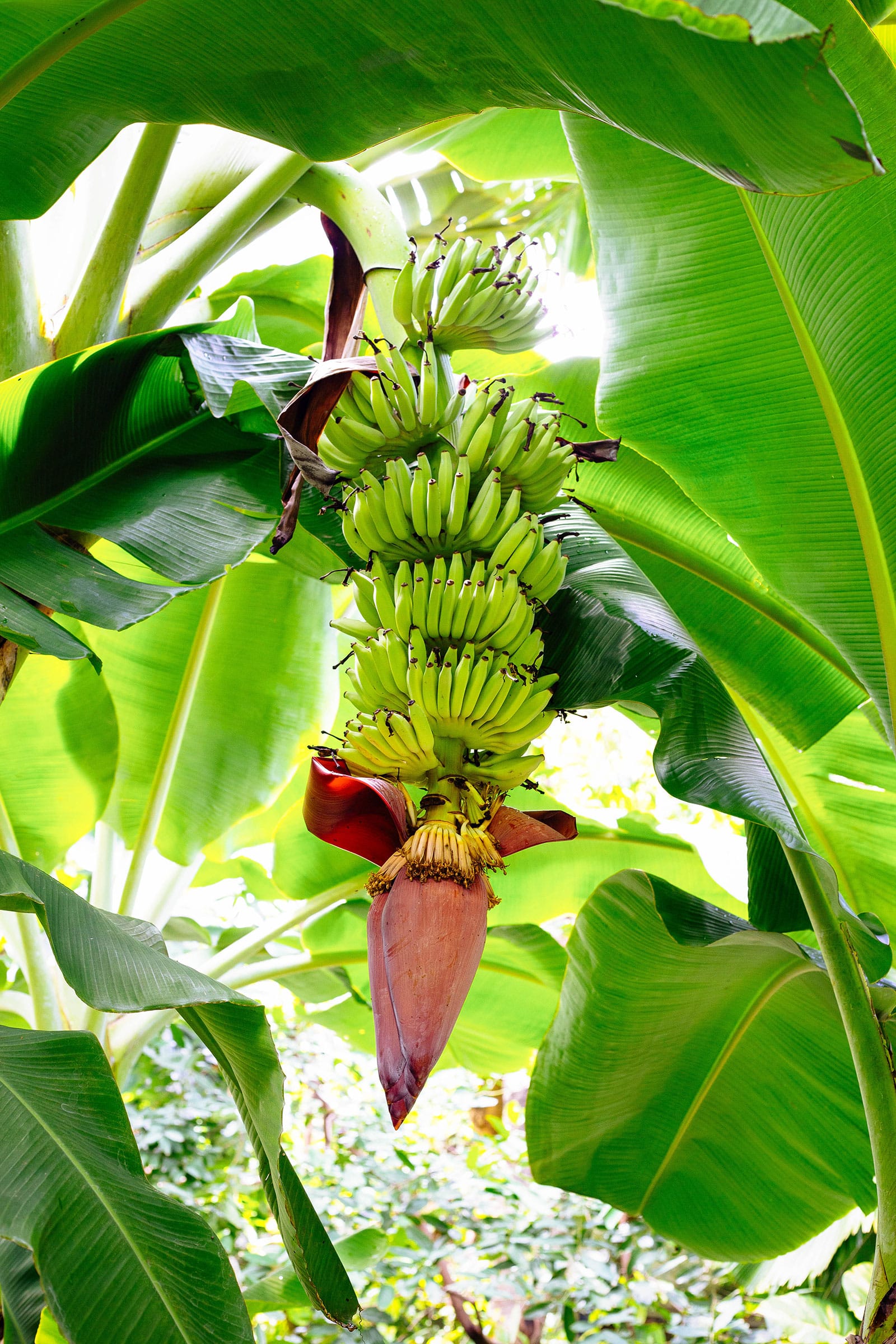
All about banana plants
Description
The common name “banana plant” is applied to a bunch of different species in the genus Musa, the bananas and plantains. The genus contains some 70 different plants, most of which aren’t edible or just not very pleasant to eat due to their large seeds. A hybrid called Musa × paradisiaca is said to be the parent of most edible banana cultivars.
Edible bananas, the result of domestication and selective cultivation by humans, have been around for a long time. Research has indicated that the cultivation of bananas, now one of the most common crops worldwide, began around 7,000 years ago in Southeast Asia. There are now estimated to be well over 1,000 different cultivars out there.
Banana plants are often confused with palms (hence their misnomer “banana palm”), but they actually form part of the order Zingiberales, alongside plants like ginger and Strelitzia (bird-of-paradise, another popular houseplant).
And while they’re usually referred to as “banana trees,” they are classified botanically as herbaceous perennials because they never form a woody stem (aka a trunk) the way a tree does—the “trunks” are actually succulent stalks (pseudostems).
Banana “trees” are characterized by their massive foliage, which are quite fragile. In banana trees kept outdoors, the leaves usually look torn and shredded, but this doesn’t bother the plant itself.
Because banana plants die off after blooming but produce plenty of offsets (also known as pups or shoots) before doing so, mature ones that have been left to grow wild will often consist of a bunch of different stems growing together.
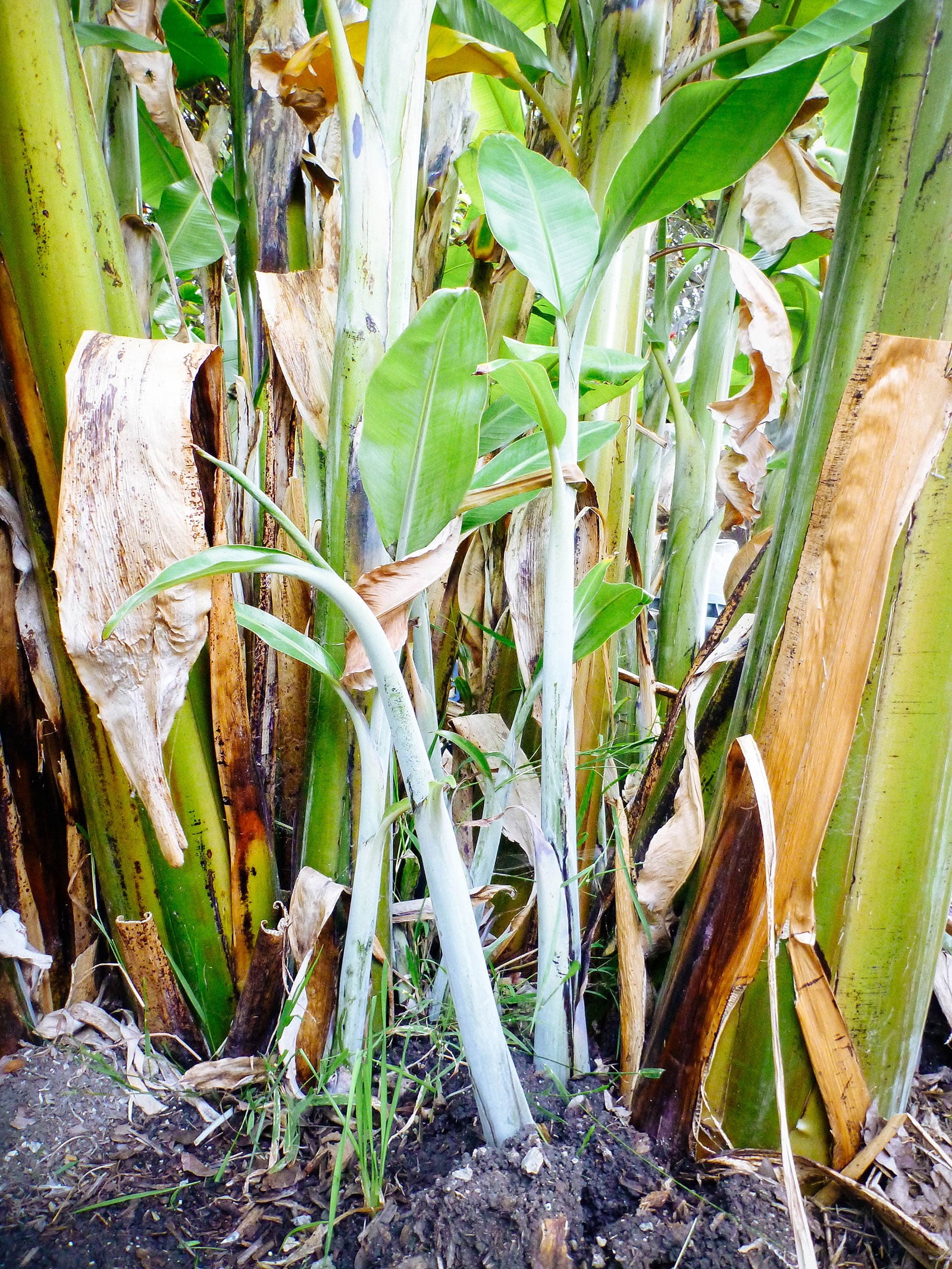
When they bloom, they form a bizarre-looking hanging stalk with bunches of fruit on top and a big, dark reddish-to-purple blossom dangling below.
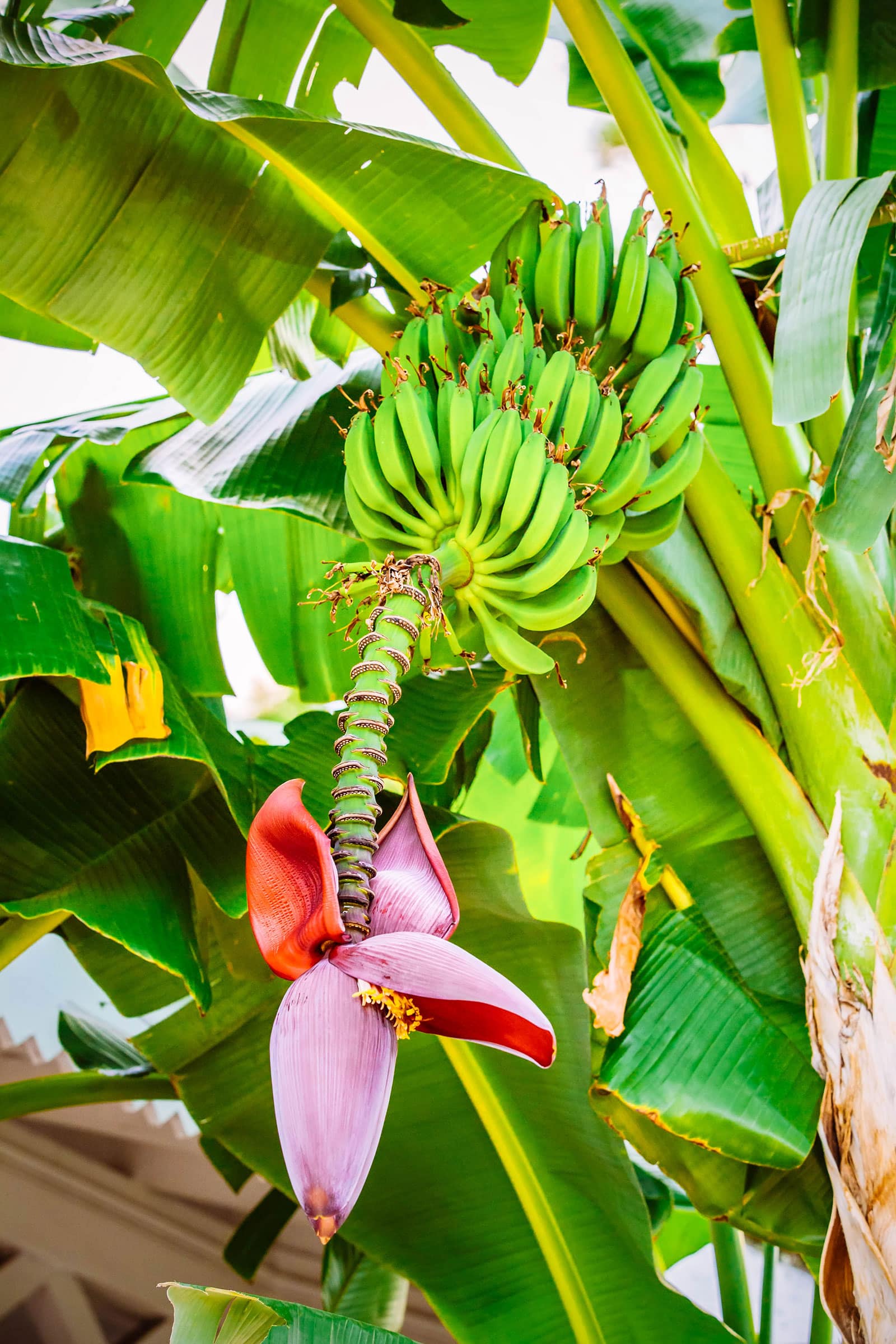
Did you know?
Because they don’t form true woody stems (at least until they bloom), but rather pseudostems that are really just made up of leaf sheaths that sprout from a central rhizome, bananas are officially considered to be herbs. And even more surprisingly, bananas are both herbs and berries!
Habitat
Although Musa isn’t a huge genus, it does have a pretty wide spread. It can naturally be found as far west as India and as far east as northern Australia, preferring tropical and subtropical regions (in what is called the wet tropical biome). Some occur in high altitude forests, while others call shrubby zones at sea level their home.
Nowadays, of course, banana plants grow in tropical regions all over the world. Humans have had plenty of time to spread them everywhere, and the banana has supported many civilizations since it was first cultivated. Musa seems to have popped up in Africa around 4,500 years ago, for example.
Meanwhile, most of the bananas exported nowadays are grown in South America. Central America, in turn, was actually the site of huge cultural unrest due to the disproportionate power that banana companies (like United Fruit Company, now Chiquita) held.
(In fact, that’s where the term “banana republic” originated—not from the mass retail store, whose corporate marketing has made most people unaware of its true etymology. But I digress.)
In Europe, the Spanish Canary Islands are huge banana exporters.
If you want to know more, I dive deeper into banana history and cultural significance here. There is so, so much more to these humble yellow fruits than what we see in our local supermarkets.
Did you know?
Unfortunately, some banana plant species are endangered in their natural habitats. Among the ones listed as Critical are M. argentii, zaifui, arfakiana, bauensis, exotica and a good bunch more. There are just a few dozen left of some of them!
The principal cause tends to be habitat loss due to human activities like agriculture, mining operations and cutting down of forests for logging purposes.
Types of banana plants
As I mentioned, there are over a thousand banana cultivars, so I could dedicate a whole book to describing all of them! Some are edible, some are ornamentals, some are both. There are loads of funky varieties to be found, like one that produces pink fruits (Musa velutina) and even variegated banana plants.
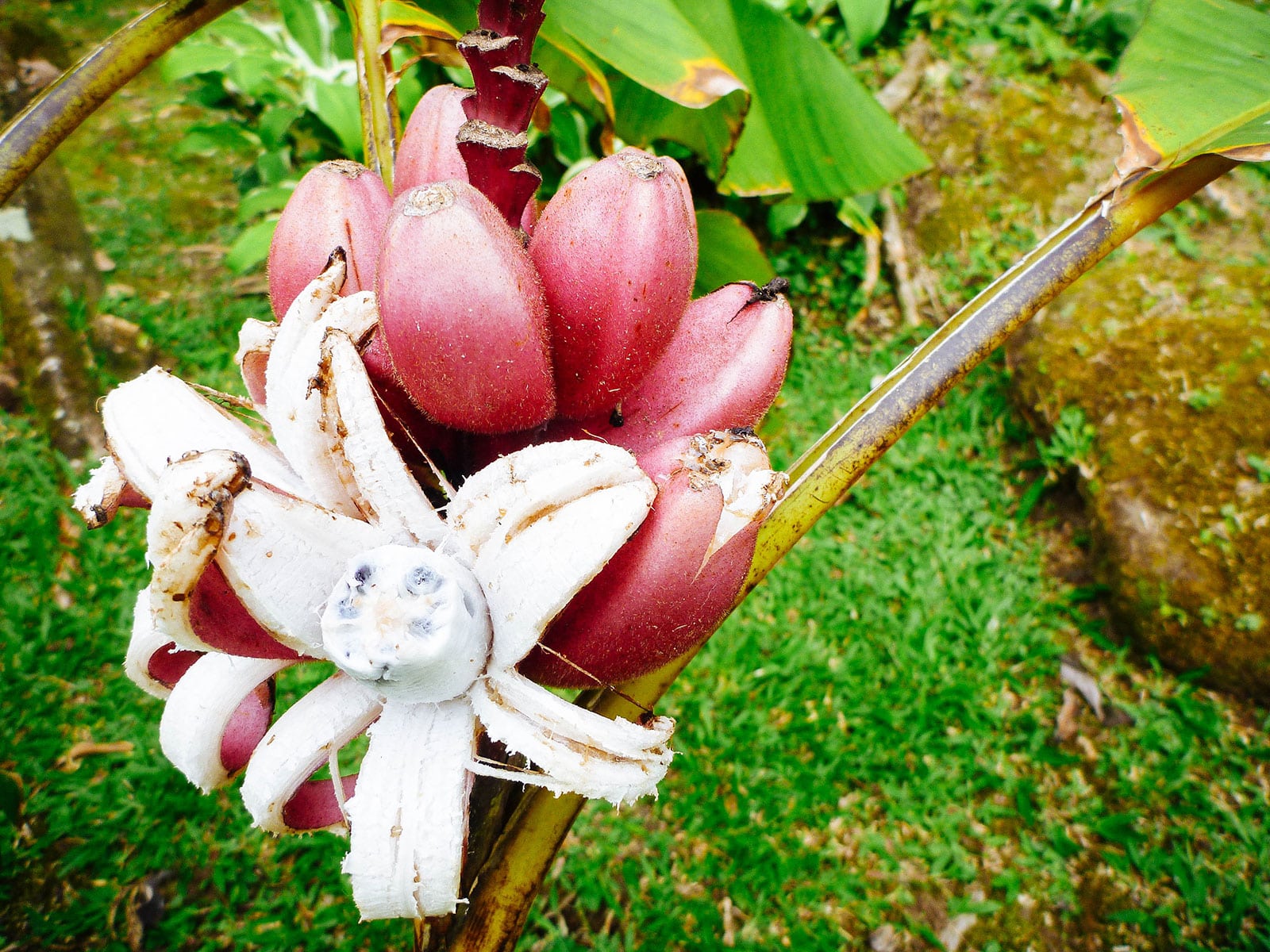
When it comes to growing a banana plant as an ornamental, the most important thing to remember is that there are large and small varieties.
Some full-sized species of Musa naturally grow to up to 30 feet high or even more, which means they aren’t really indoor, balcony, or patio material. Something like a Dwarf Cavendish, however, doesn’t tend to surpass 10 feet.
Here are a few types of banana plants you may come across at your local garden center:
- Musa acuminata ‘Dwarf Cavendish’: Up to 10 feet high, but usually smaller. Produces large bunches of sweet fruit.
- Musa basjoo (cold-hardy banana tree): Also known as the Japanese banana. Its roots will survive winters as far north as USDA zone 5. Grown as an ornamental only.
- Musa ‘Dwarf Red’: A beautiful little plant with both partially red leaves as well as dark red-skinned fruit!
- Musa ‘Florida’: If you have some money to burn ($150+ for a baby plant), you can get this beautiful and coveted green-and-white cultivar. Apparently, even the fruit is variegated!
- Musa acuminata ‘Grand Nain’: You’ll find the fruits of this one in grocery stores worldwide, like those by Chiquita.
- Musa acuminata × balbisiana ‘Blue Java’ (ice cream banana): This species grows to up to 15 feet tall and produces delicious, custardy fruit with a beautiful blue-green skin.
- Musa ‘Siam Ruby’: Almost entirely red leaves with barely any green. The fruit isn’t that palatable, but with those foliage colors, who cares?!
- Musa ‘Pisang Ceylon’: Produced by a company called AgriStarts as an improvement on Musa ‘Mysore’, which was too sensitive to Banana Streak Virus. The tasty small fruits are called lady fingers.
- Musa ‘Rajapuri’: Small (less than 10 feet tall) banana plant that produces delicious, small fruits.
- Musa acuminata var. Zebrina (blood banana): Very decorative ornamental with red-streaked green leaves.
- Musa ‘Dwarf Puerto Rican’: Here’s one for those who love plantains (cooking bananas) as much as I do. It’s diminutive, but produces fruit perfect for frying or making banana chips.
Where to buy
Some banana plants are not banana plants at all.
For example, one member of the family Musaceae you might find for sale is the Red Abyssinian banana, which doesn’t actually produce edible fruit but is cultivated for its nutritious corm. It’s not a Musa, but instead called Ensete ventricosum. It’s very decorative and its care requirements are similar to that of true bananas!
Another example is the golden lotus banana, the sole member of the genus Musella in the family Musaceae. This one was named for its beautiful yellow blooms.
Growing a banana plant indoors
Are banana plants suitable as houseplants?
Although your banana plant will love living outdoors at least part of the year, it can do well indoors too. Just remember that these are tropicals, which hail from extremely sunny, humid regions. They like the comfy temperatures in our homes, but you need to make sure you meet their other needs as well.
You’ll want to place your banana right in front of the sunniest window you can offer, unless you’re willing to set up grow lights. It’s also important to keep the humidity high, or those large, lush leaves will soon be crispy and brown.
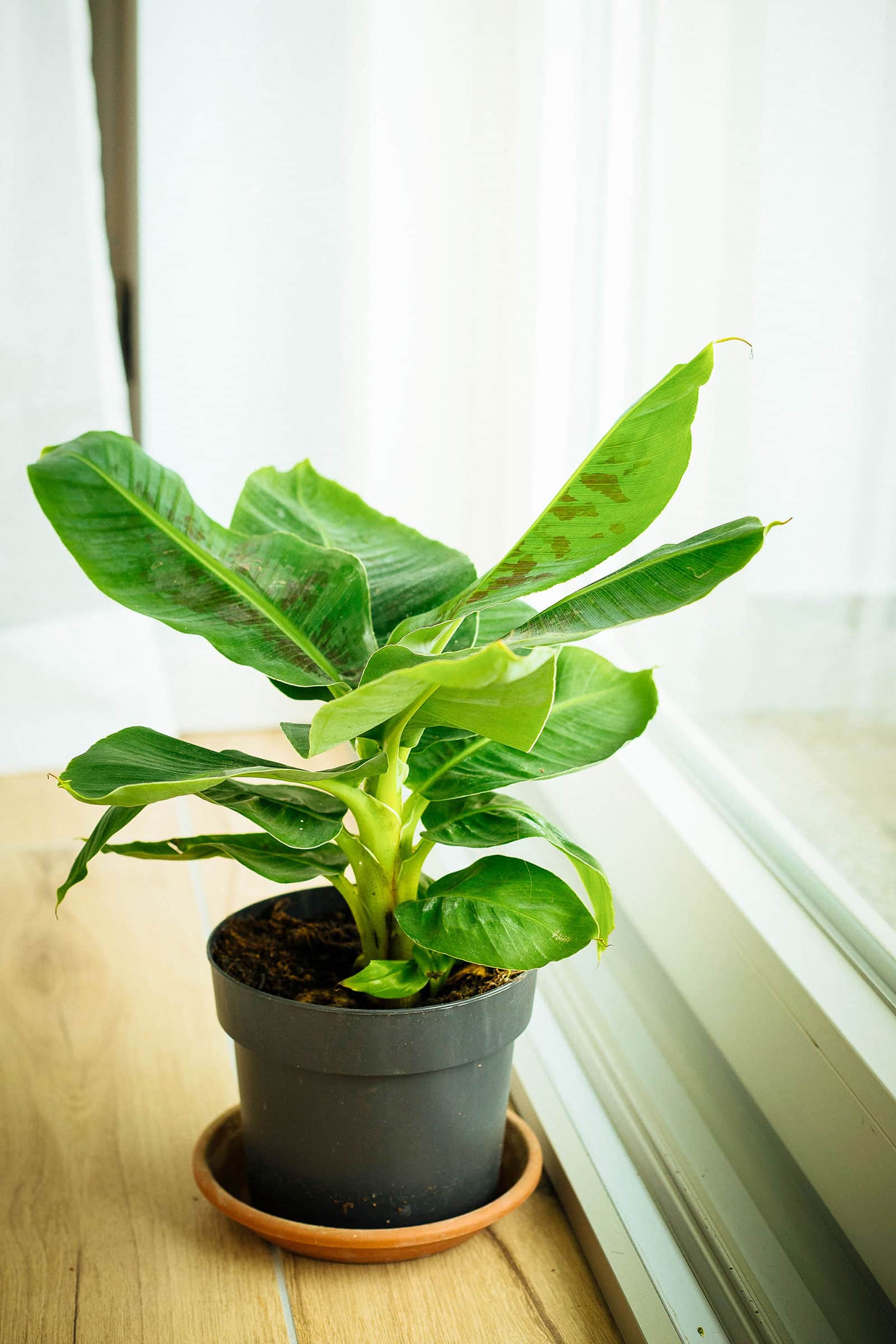
If you’re only overwintering your banana plant indoors, that’s a little easier. The best thing is to leave it alone as much as possible. It won’t grow much and might lose some foliage, but it’s just biding its time until it can return outside.
Indoor banana plant varieties
As mentioned in the section on banana plant varieties, there are some species and cultivars that stay under 10 feet. If you keep these indoors, where their growth is often a little stunted compared to outdoors, they likely won’t outgrow your home any time soon.
Indoor banana plants generally won’t fruit, so you don’t have to worry about whether the type you’re after produces edible bananas or not. Consider one of the following, for example:
- Dwarf Cavendish
- Truly Tiny (Dwarf Cavendish’ even smaller sister)
- Dwarf Red
- Rajapuri
- Dwarf Puerto Rican
- Dwarf Orinoco
- Veranda
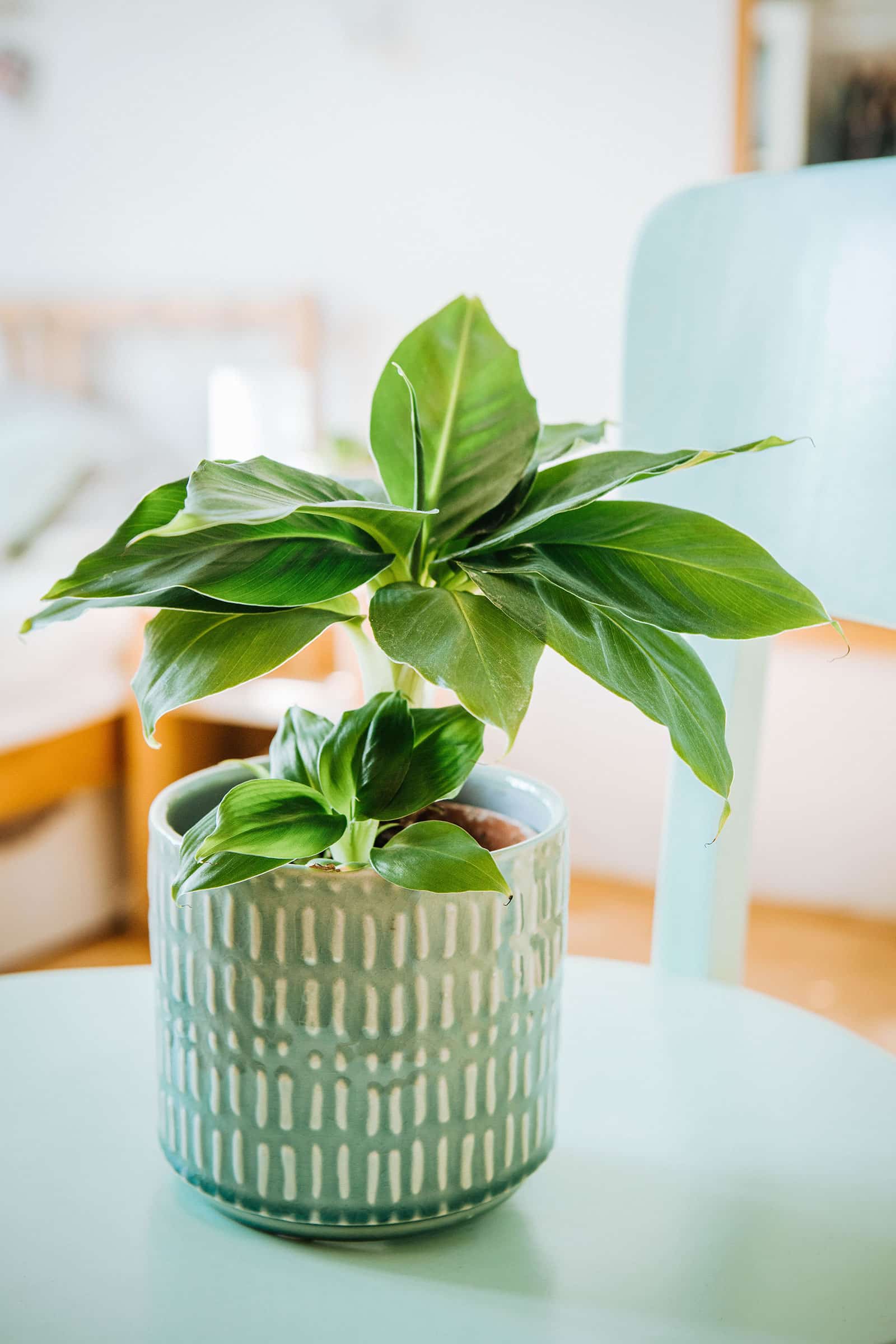
Indoor plant care
Planting
Once you’ve found a nice and sunny spot for your banana plant, you can plant it in a container with a drainage hole and rich, acidic but well-draining soil. Everyone has their own favorite mixtures, but something like this is a good starting point:
- 3 parts peat
- 1 part perlite
- 1 part vermiculite
- Some compost, worm castings or other organic material
If you want your banana plant to grow big, be sure to repot on a yearly basis, choosing a container that gives it plenty of space. To slow down its growth a little, you can opt to leave it in a smaller container for longer. They don’t mind being a bit root bound.
Recommended products for indoor banana plant care:
- Hoffmann Canadian Sphagnum Peat Moss
- Perfect Plants Organic Perlite
- Harris Horticultural Vermiculite
- Wiggle Worm Soil Builder Pure Worm Castings
Watering
When growing a banana plant indoors, overwatering is more of a risk than outside. Still, these plants do like plenty of moisture, so keep the soil lightly moist.
You may have to water as often as twice a week during the summer months, while in winter, your plant may only need water every one-and-a-half weeks or even more infrequently. You can check the soil moisture level by sticking your finger in the pot; water when the top 2 to 3 inches feel dry.
Aside from watering, as mentioned, it’s important to keep the humidity up. If your home regularly drops under 40 to 50 percent humidity, it might be a good idea to run a humidifier. Your banana plant, your other tropical houseplants, and your own sinuses will thank you.
It will even help prevent pesky spider mites from infesting your tree. They love banana plants’ big leaves, but they prefer dry air.
Fertilizer
Although they don’t need quite as much in terms of fertilizer indoors, your banana plant will still appreciate a regular little boost. They’re always working on new leaves that need nutrients to grow!
You can use a normal liquid balanced houseplant fertilizer every other week or so while watering. Don’t fertilize if your banana is dormant during winter.
Recommended fertilizers for banana plants:
- Elm Dirt Plant Juice Organic Fertilizer
- Houseplant Resource Center Liquid Fertilizer for Houseplants
- Instant Biologics Instant Plant Food (Fizzing Nutrient Tablets)
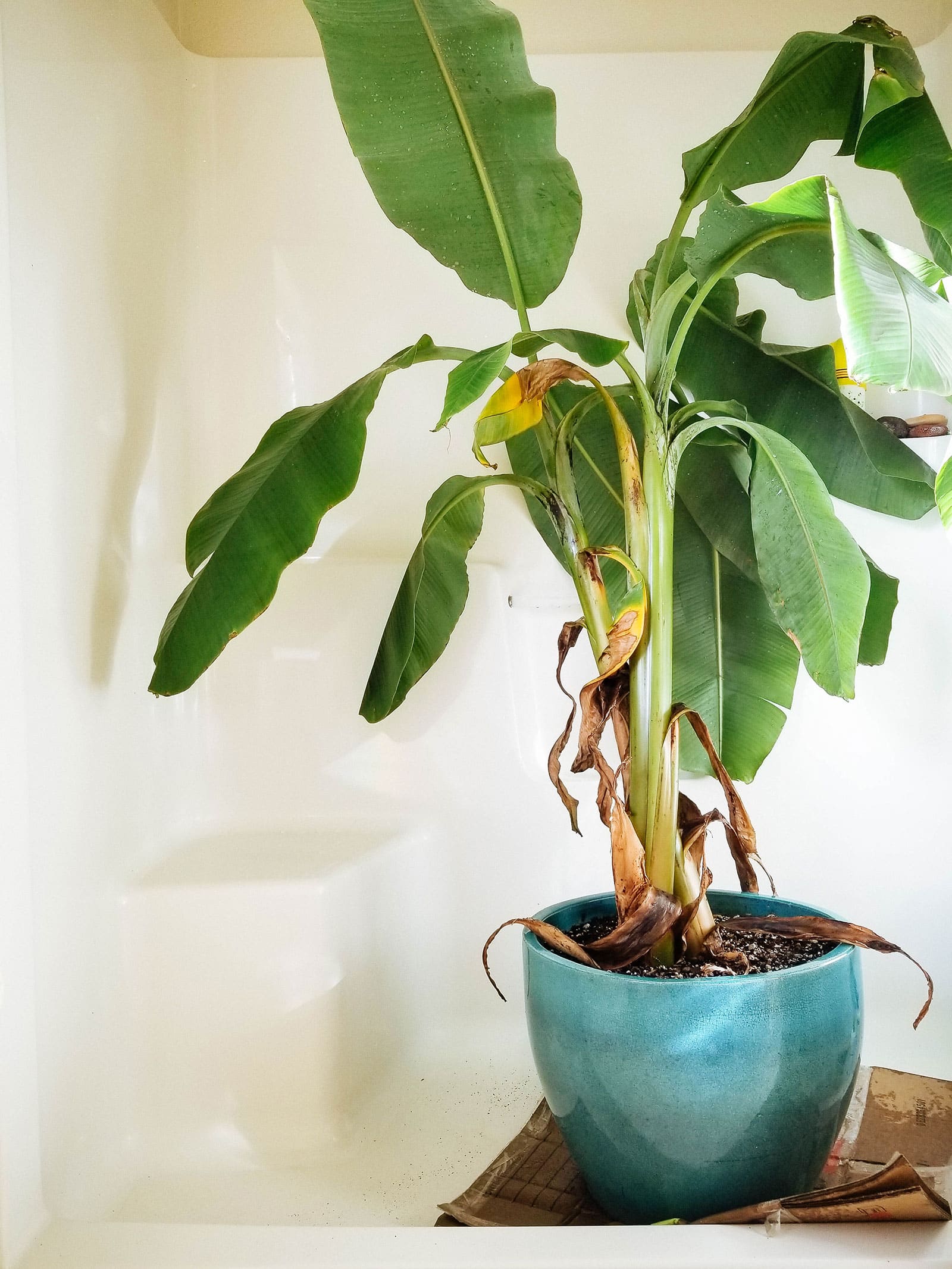
Growing a banana plant outdoors
Can a banana plant overwinter outside?
As you probably guessed, the answer to that question depends entirely on where you live, as well as what kind of banana plant you’re growing. It also depends on whether you’re growing for fruit or for the plant’s ornamental value.
If you want to be able to keep the plant outdoors year-round in a cooler zone, you’ll have to go for the hardy varieties that don’t produce nice fruit.
The most cold-hardy bananas are Musa basjoo and the somewhat harder to find Musa sikkimensis (Darjeeling banana), which hails from high-altitude regions in Bhutan and India. The roots on these species can survive in USDA zone 5 or up.
Even though the stems will die off, they come right back in spring. Since bananas are quick growers, yours will be back to last year’s glory before you know it!
Basjoo and Darjeeling bananas are grown for their ornamental value, not their unpalatable, seed-filled fruits. If you do want to keep a fruiting banana outside year-round, this can easily be done in zone 10, but becomes more difficult in cooler zones.
Depending on the cultivar (check before you buy), some, like ‘Dwarf Orinoco’ will survive as far north as zone 7b.
Mulching your banana plant thickly in winter, using frost covers, and any other protection you can offer can help the corm (or even the whole plant) make it through until spring.
Outdoor banana plant care
Light
As with indoor banana plants, the most important thing for your outdoor banana is sun. Sun, sun, sun! They love soaking up as much as they can get for good growth.
If you’re planting in the ground, choose the spot carefully. You won’t be able to change your mind until the tree produces its first offsets.
Planting
Outdoor container growing can be a little challenging because the plant will be less resilient and grow slower, but it comes with the huge advantage of being able to move your banana plant indoors if things get chilly.
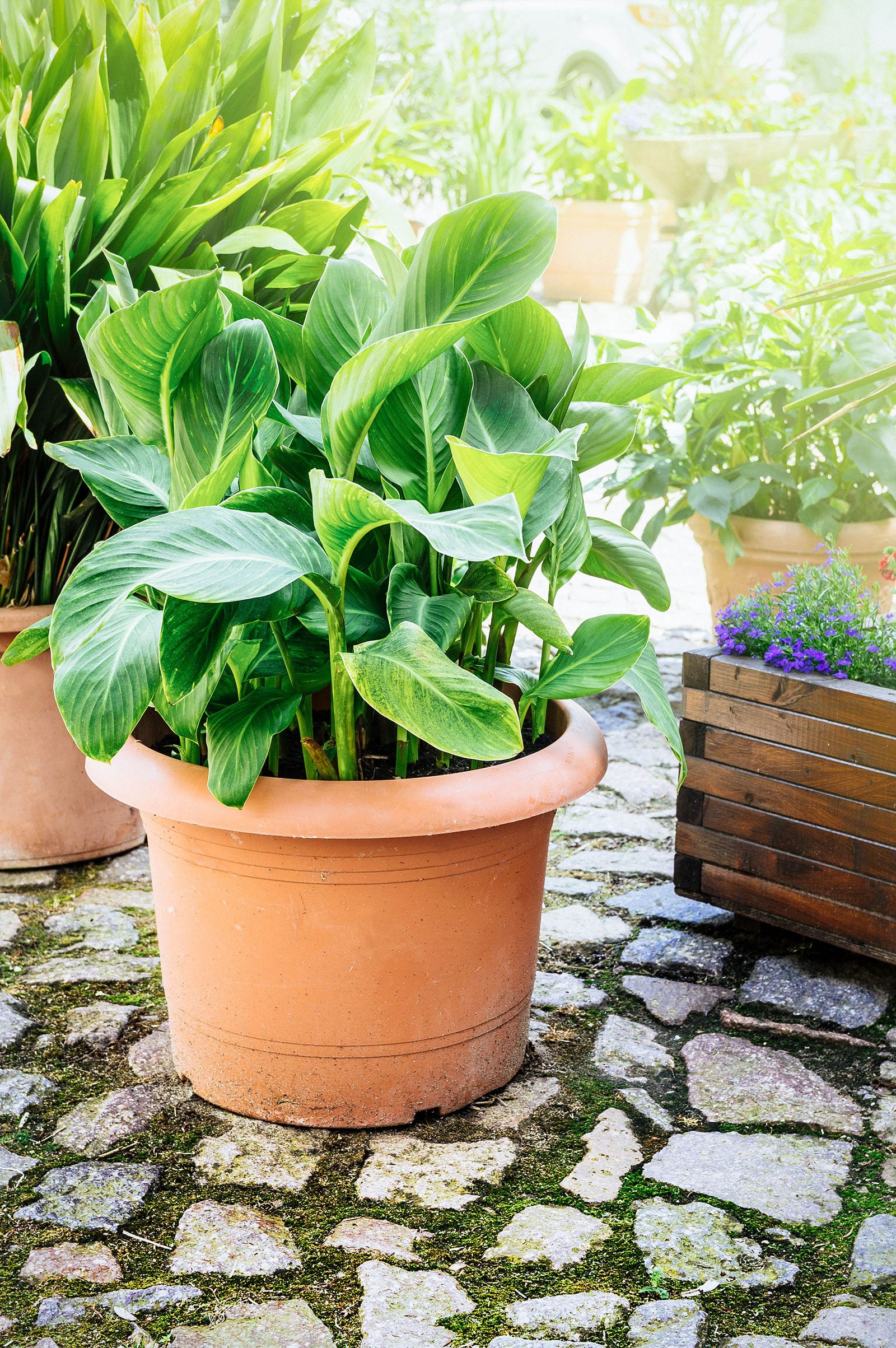
If you are planting in a pot, scroll up to the instructions for the ideal banana plant soil mix described in the section on indoor care. Consider adding a little less grit than usual, because these guys are very thirsty plants and the soil may dry out too quickly otherwise—at least in summer. A little more compost can go in its place.
If you want to plant your banana in the ground, choose your site carefully. The plant will grow tall and wide, so you don’t want it shading any nearby plants that require full sun. It will also multiply rapidly via shoots, so your one banana plant can turn into several within a couple of years if you keep all the shoots.
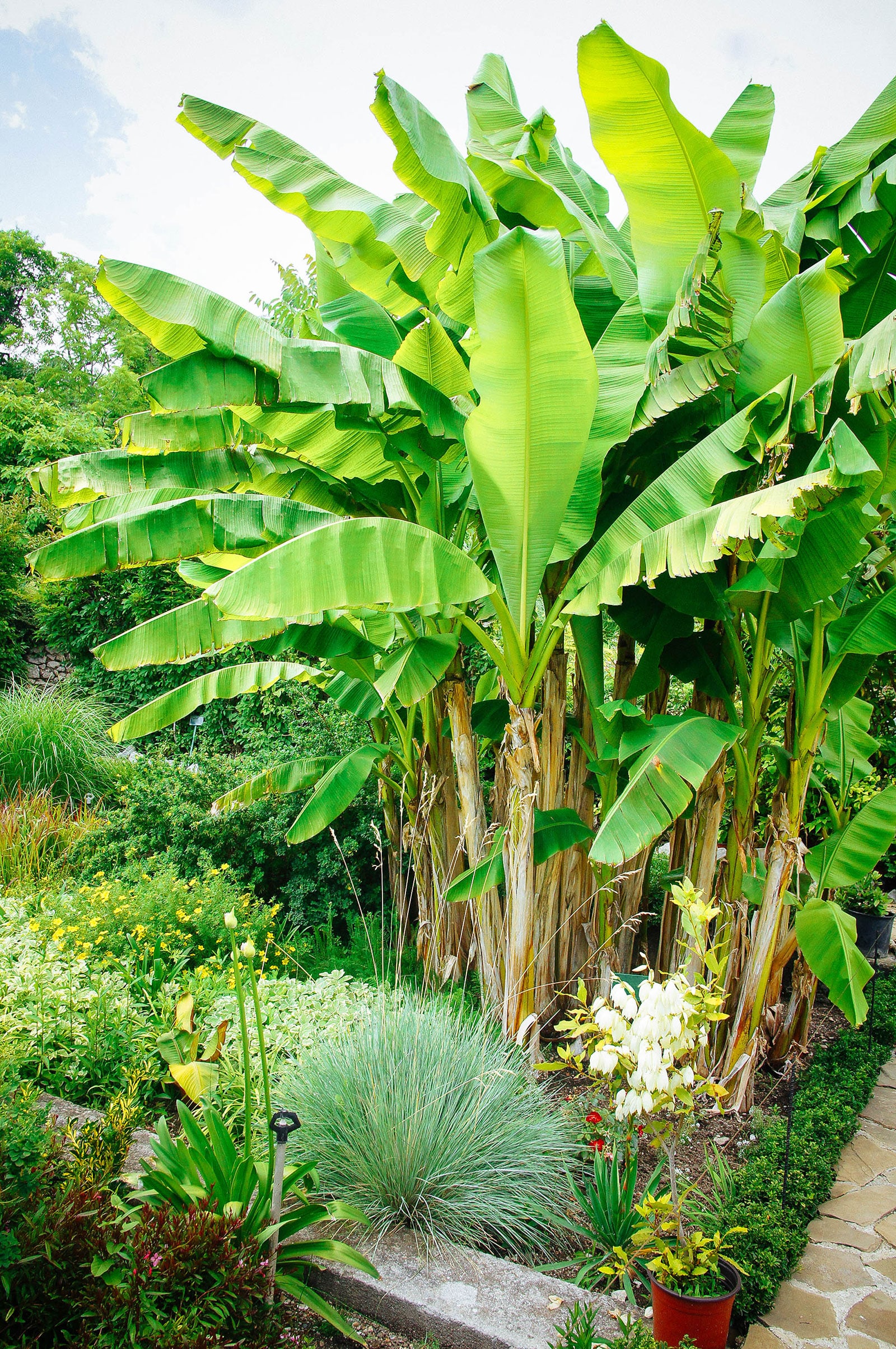
For growing in full soil, just dig a hole that’s around twice as large as the container you bought the plant in. Take the plant out of its pot, gently shake the excess soil from the roots and pop it in the hole. Backfill with more soil, add a 1- to 2-inch layer of compost on top, and water it in well.
Most banana plants recover from being planted within a week or two and continue growing as if nothing happened!
Water
Whether your banana plant is in a pot or in the ground, it will love lots of water during summertime. Unless you live in a place that gets plenty of rain, you’ll have to water every other day or so.
During winter, unless it stays warm where you live, they need a lot less. After all, when exposed to the cold, they go almost fully dormant and stop growing.
Be careful not to overwater! The soil should be lightly moist, but never wet, in order to prevent deadly root rot. Containers should always have a drainage hole.
Fertilizer
Because they’re such quick-growing plants when you keep them outdoors, bananas are heavy feeders and need regular doses of NPK during the spring, summer, and early autumn months to do their best.
My top choices for banana plant fertilizers include compost (applied once a year in early spring), worm castings, or a good all-purpose fertilizer or fruit tree fertilizer, applied per the package’s recommended schedule.
Recommended fertilizers for outdoor banana plants:
- Wiggle Worm Soil Builder Pure Worm Castings
- Down to Earth Organic All-Purpose Fertilizer
- Dr. Earth Natural Wonder Organic Fruit Tree Fertilizer
Will it produce fruit?
If the banana plant can keep growing year-round in your zone, or if you bring it indoors to shelter it from winter temperatures, it’s definitely possible. Most banana varieties need nighttime temperatures of at least around 70°F during the summer fruiting season, but your mileage may vary. It’s always a bit of trial and error!
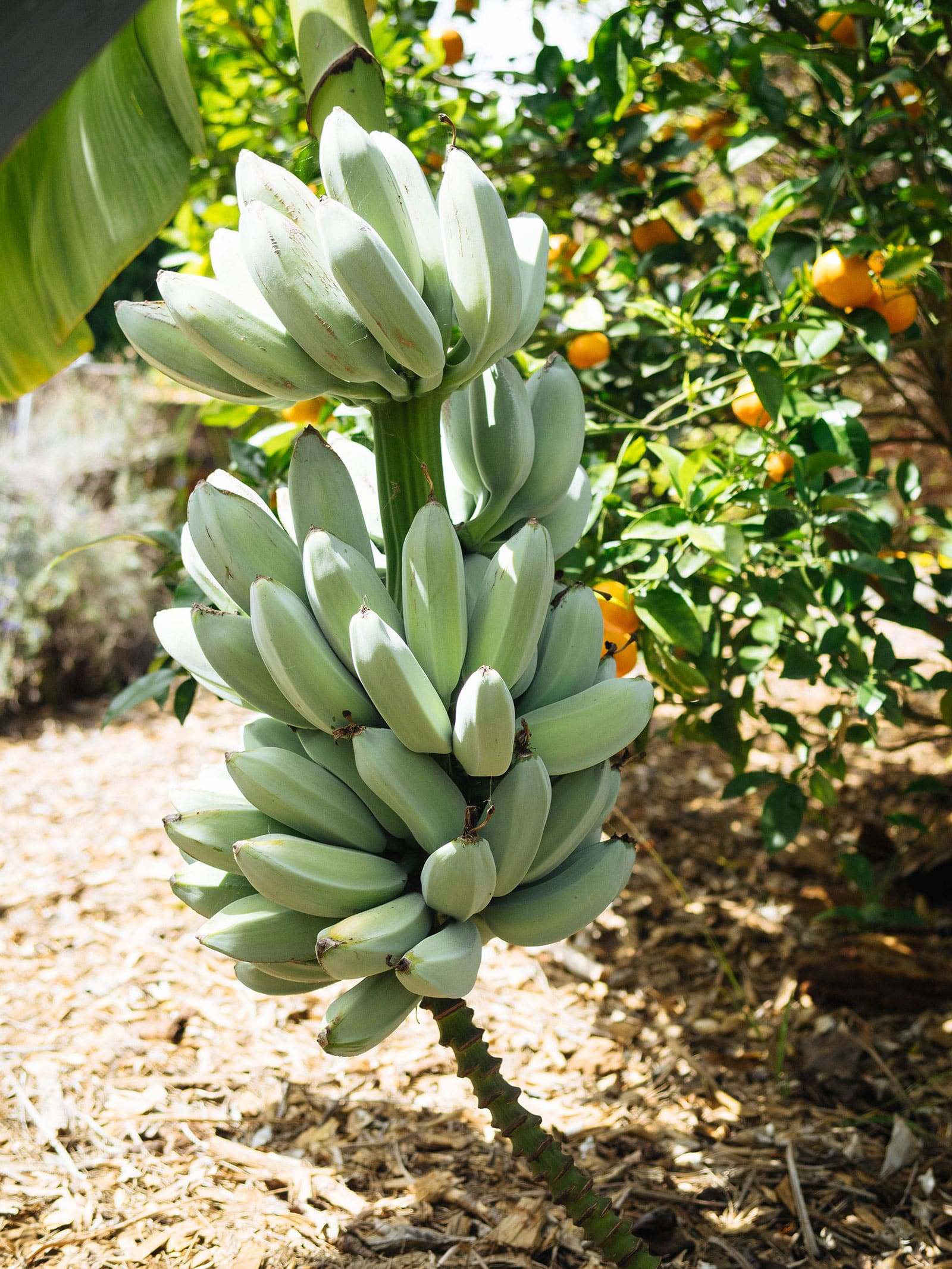
Once your plant begins fruiting, refer to my guide on how to harvest at the right time and keep the bananas from splitting.
Staking or supporting a banana plant
Your banana plant will become quite top-heavy as it grows taller and the banana bunch matures. Without support, it’s not uncommon for banana plants to topple over in the wind or collapse under the weight of their own fruit.
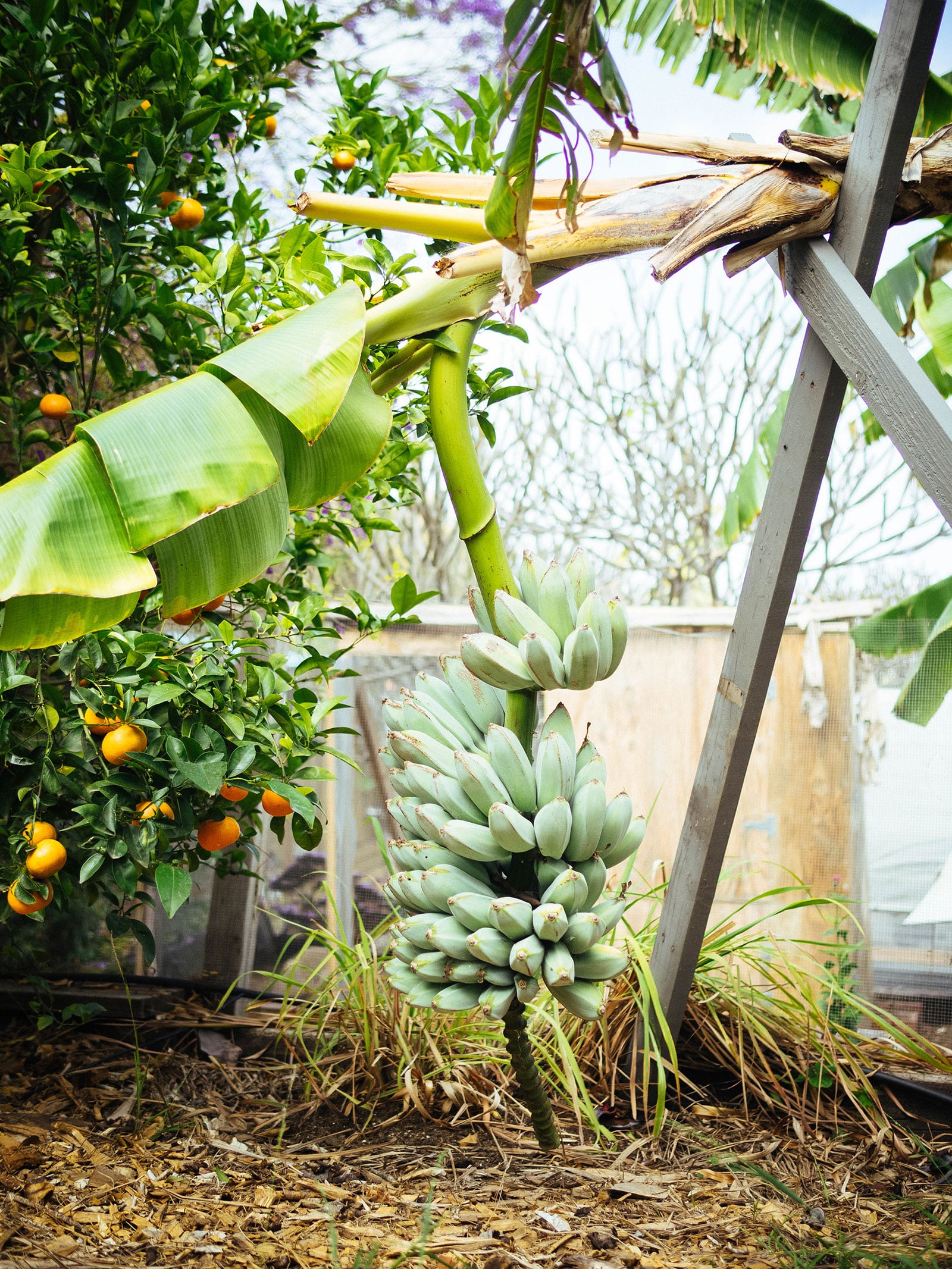
To keep your banana plant from falling over or bending in half, you’ll need to brace the stem with a tall, sturdy support. I typically use 2×4 scrap lumber, wedged under the stem at an angle and nestled securely in the ground. (Thick bamboo poles or large PVC pipes also work.)
How to trim a banana plant (and propagate it!)
There are two situations in which you’ll want to trim your banana plant: If it’s looking a bit scruffy due to yellowing or dead leaves, or after it has finished flowering and fruiting. The former is easy… As long as the plant is not producing fruit, just remove the leaves you don’t like the look of.
The latter isn’t too complicated either, but it does involve chopping down the entire main stalk. After all, a banana plant will die back after fruiting—don’t be alarmed when this happens.
Before it completely dies, however, the mother plant will produce one or multiple pups (offsets) at its base that will take over next year.
To prevent the large, spent stalk from causing rot or crushing the pups when it eventually goes down, it’s best to just cut it yourself. The stem isn’t hard, so it shouldn’t be too difficult with a hand saw.
After you’ve sacrificed the mother plant, you can leave the healthiest-looking offset in its place so it can shine next year. The others can be carefully dug up and removed so they don’t compete for nutrients.
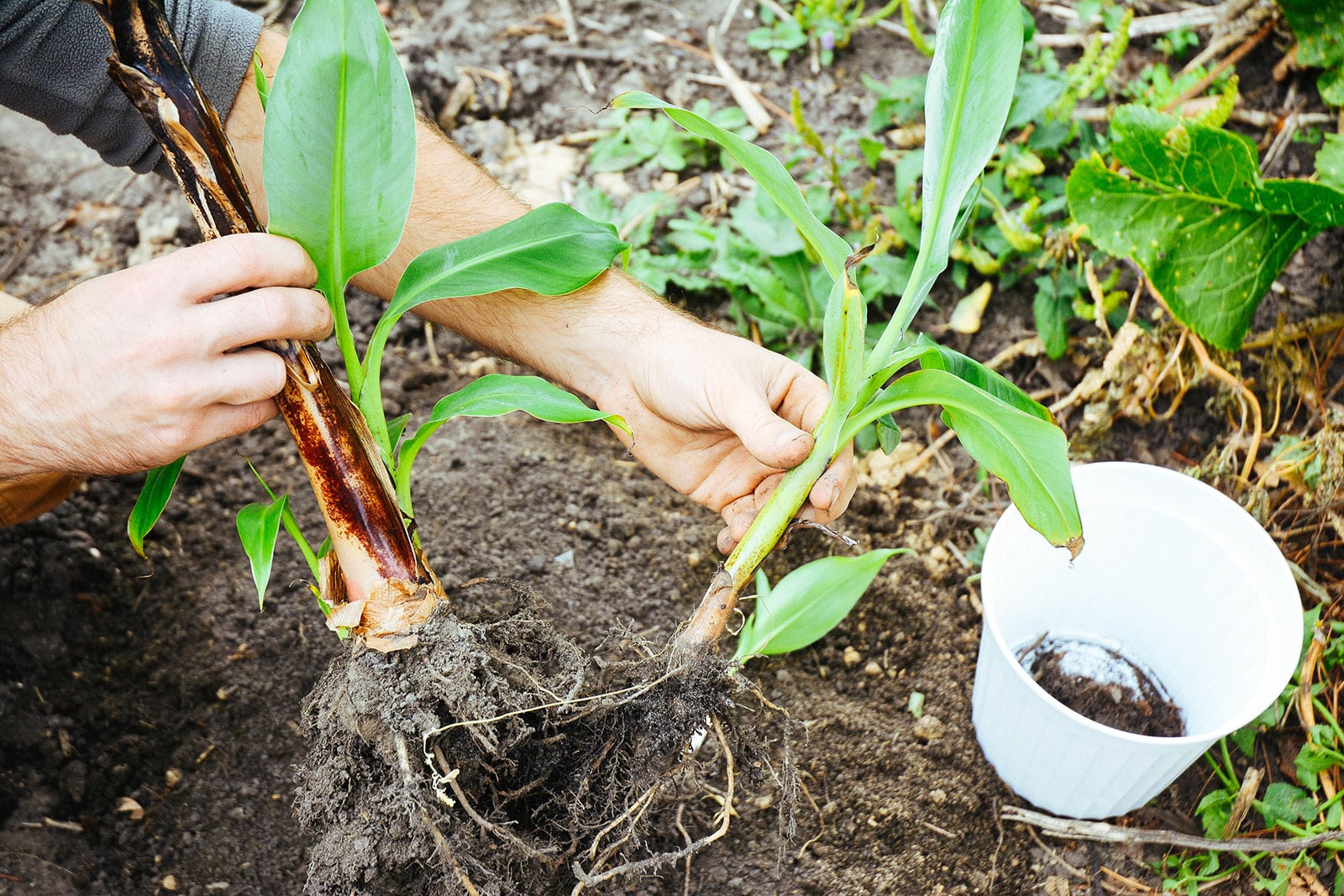
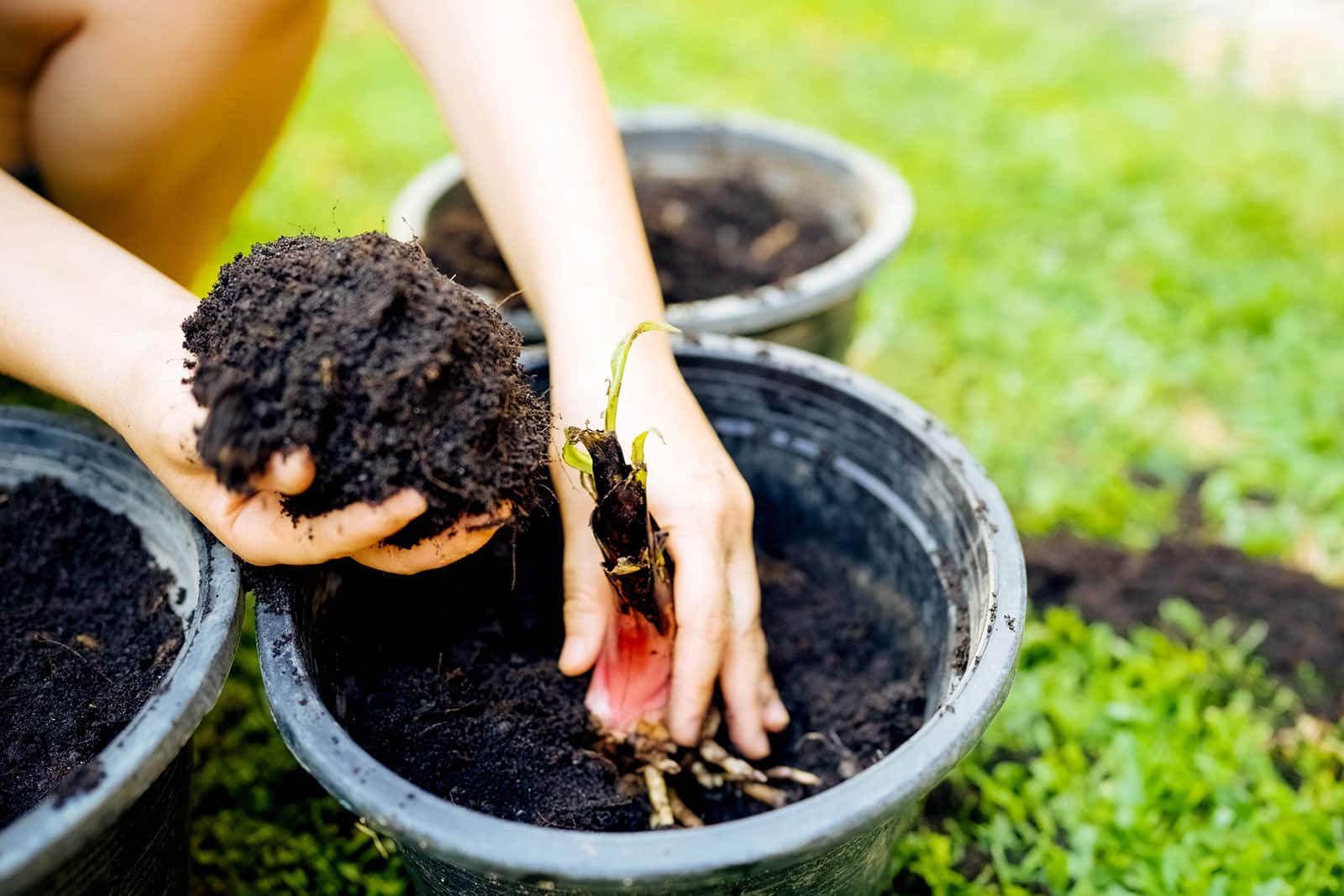
This is not a must, and multiple large stalks left together do give off sultry jungle vibes that make you feel like you’re on a tropical vacation. Personally, I’ve often let two or three pups (from the same mother) mature into full-grown plants side by side. But, leaving only one specimen can help with fruit production if you’re serious about that.
You can plant the pups you removed somewhere else or give them away. Remember, most domestic bananas don’t produce proper seeds, so using the pups is really the only way to multiply yours.
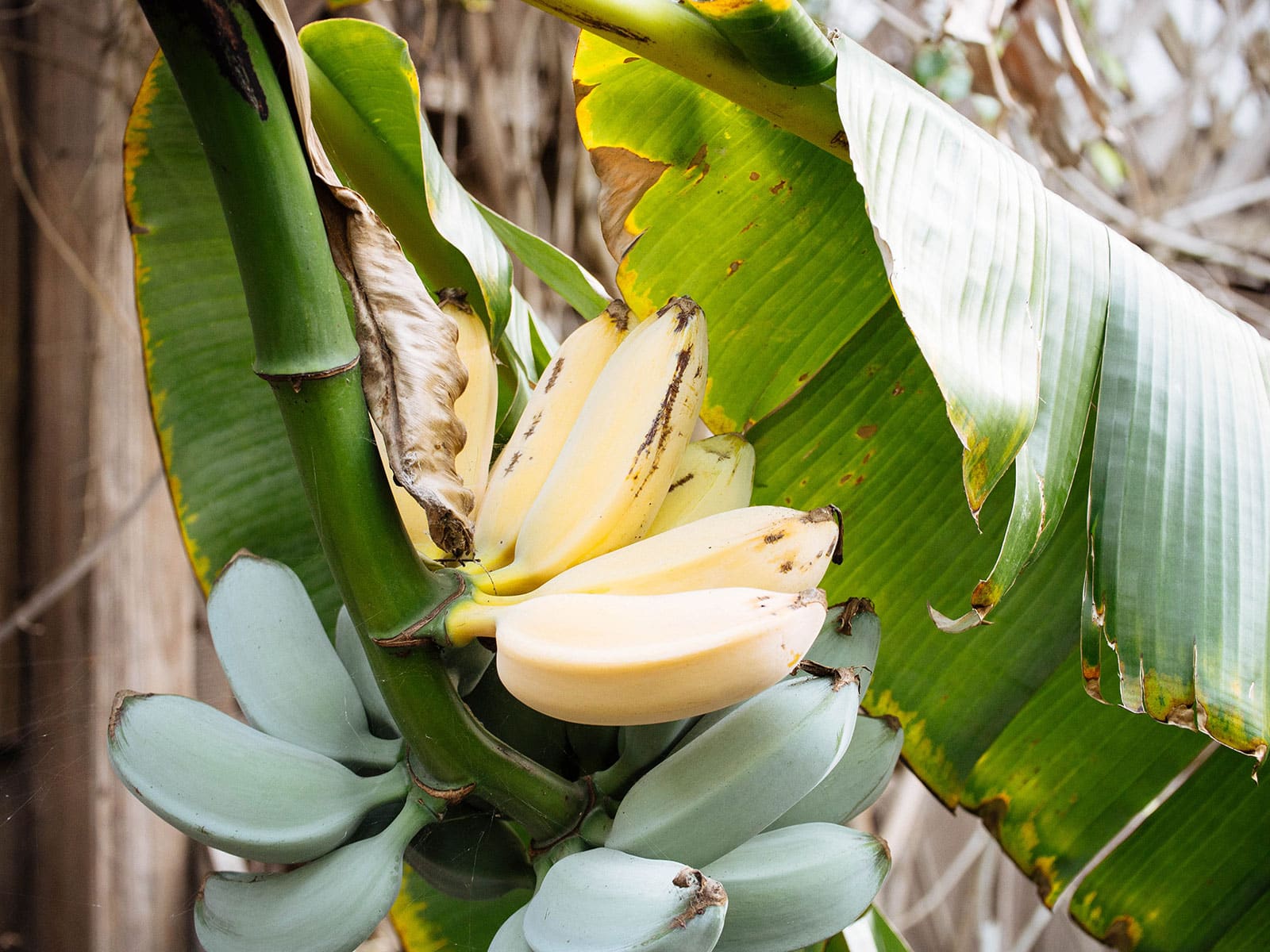
Common questions about growing bananas
Do banana plants produce fruit indoors?
Let’s put it this way: I’d be very surprised if my indoor banana plant managed to successfully develop a bunch of bananas.
If you want fruit, your best bet is to place the plant outdoors during summer, although there are still no guarantees. Although they survive and grow alright, indoor conditions and lighting are just not ideal for them.
How fast do banana plants grow?
Indoors, as long as they get plenty of sun, banana plants grow plenty fast. They’ll almost always have a new leaf unfurling, except maybe in the dead of winter.
Outdoors, banana plants grow insanely fast. They can reach their full potential height in under a year. That can be up to 30 feet!
What are signs of an overwatered banana plant?
An overwatered banana plant will show symptoms like yellowing leaves, brown spots, and/or mold on the stem. In extreme cases, the stem can even go mushy.
Remember to use well-draining soil and a planter with a drainage hole. Plants need less water in winter.
Are banana plants toxic?
Nope! Banana plants are safe to grow around dogs, cats, and other animals.
References:
- https://www.science.org/content/article/early-africans-went-bananas
- https://powo.science.kew.org/taxon/urn:lsid:ipni.org:names:327926-2
- https://www.iucnredlist.org/search?query=musa&searchType=species
- Li, L. F., Wang, H. Y., Zhang, C., Wang, X. F., Shi, F. X., Chen, W. N., & Ge, X. J. (2013). Origins and domestication of cultivated banana inferred from chloroplast and nuclear genes. PLoS One, 8(11), e80502.
This post updated from an article that originally appeared on February 1, 2023.


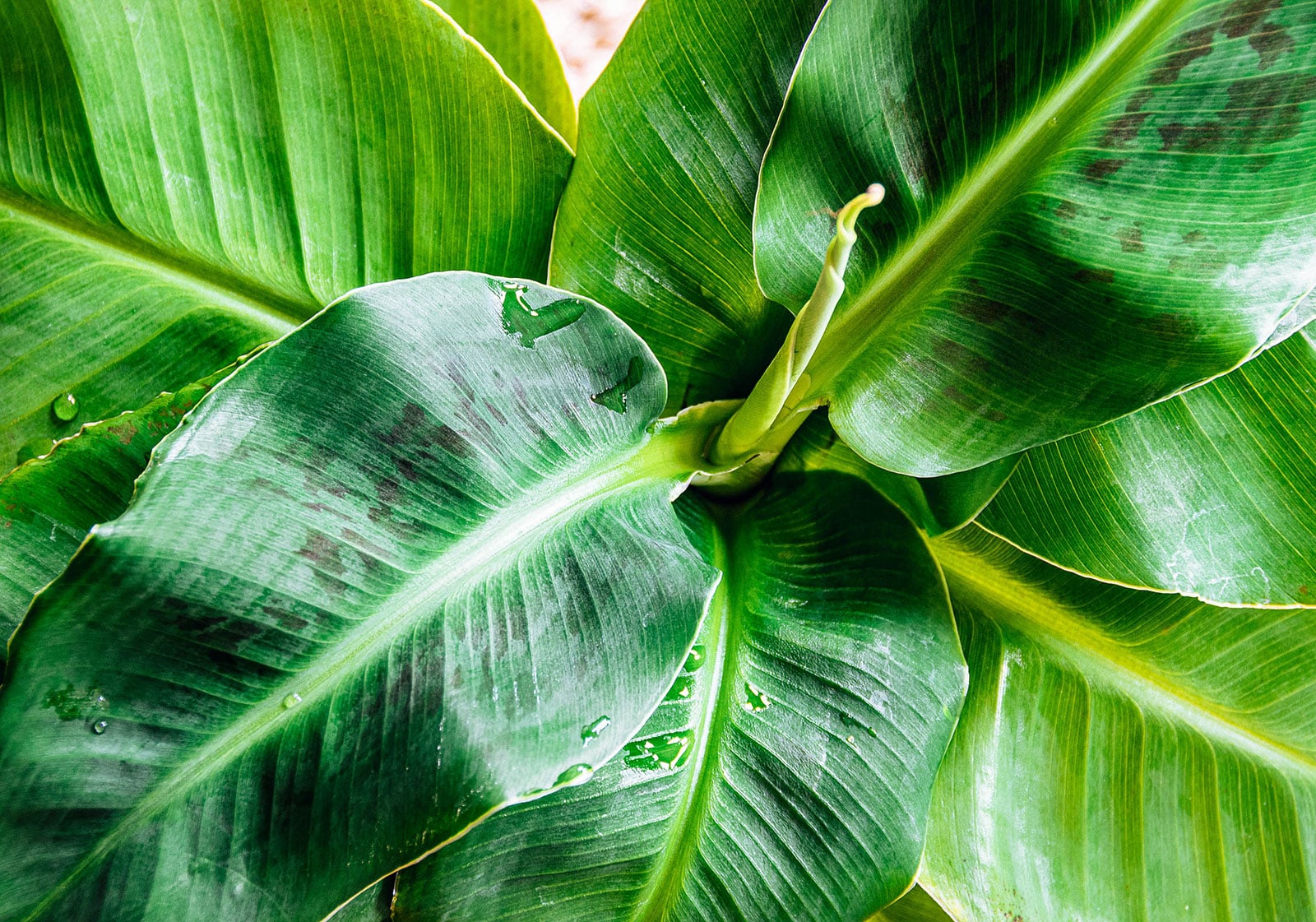













Thanks for all you great information.
I have had my banana plant since a pup was given to me 16 months ago. It is a delightful plant to grow. Been indoors since I got it. Living in southern NH.
Found it difficult to repot when it outgrew the 1st one. Don’t think I can do another repotting as it is 5 ft. tall and wide. Wondered if I get some pups, would it be best to plant it into a large pot to begin with???
Diane